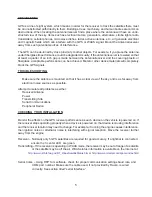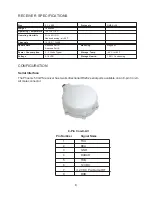
4
At this point, the power is connected to the mounted receiver. The Phoenix 50 will be looking for
satellites, which may take a few minutes. Eventually, if the antenna has a clear view of the sky, the
receiver will send data to the lightbar or other serial interface devise.
Wait for the receiver to find and track the WAAS signal, it could take 15 or more minutes before the
receiver gets the necessary almanac data from the selected WAAS satellite. This initial startup time is
necessary only during the first time the receiver is used. Once the broadcast is found the receiver will
power up and start receiving signals after about 20 seconds. If a signal is not received within about 30
minutes there could be some form of interference or the receiver may not be in the coverage area of
the selected WAAS satellite.
At this point, the receiver should be tracking satellites and generating good differential position. Start
turning on other equipment on the machine. A device could interfere with the GPS satellites or WAAS
signals. Wait about 30 seconds after each device is turned on to see if the receiver stops tracking
satellites. Finally, start up the machine and again watch for any problems.
If after turning something on, a problem is found, try moving the antenna further away from that device.
Check that the device is functioning properly and also check its power connections. Some devices
can generate too much noise naturally or because of defective components.
Now the receiver is working with everything that could interfere. Shut everything off, mount the re-
ceiver, and route the cables. Once this is done, repeat the power up steps.
The last few steps deal with connecting the other equipment that gets data from the Phoenix 50. Refer
to the manufacturer’s documentation for details such as baud rates and required messages. It is very
likely it will only be necessary to connect the interface cables to the device. The Phoenix 50 is config-
ured, by default, to work with most systems without any adjustments.
All configuration and WAAS data is stored in non-volatile memory inside the Phoenix 50. If it is neces-
sary to change the WAAS or GPS setups, run the receiver software to make the changes.
POWER
The Phoenix 50 receiver needs DC power between 9 and 16 Volts. DC power is usually provided by
battery on the machine or via a power adapter of some type. If the unit came with an automotive
power adapter, verify that the vehicle has a negative ground system before connecting power. If the
unit came with an AC adapter, it will be necessary to only connect the adapter to an AC source.
Summary of Contents for Phoenix 50
Page 1: ...Phoenix 50 Installation Operator s Manual P N 016 0171 211 Rev A 06 15 Copyright 2009 ...
Page 13: ......
Page 14: ......

































